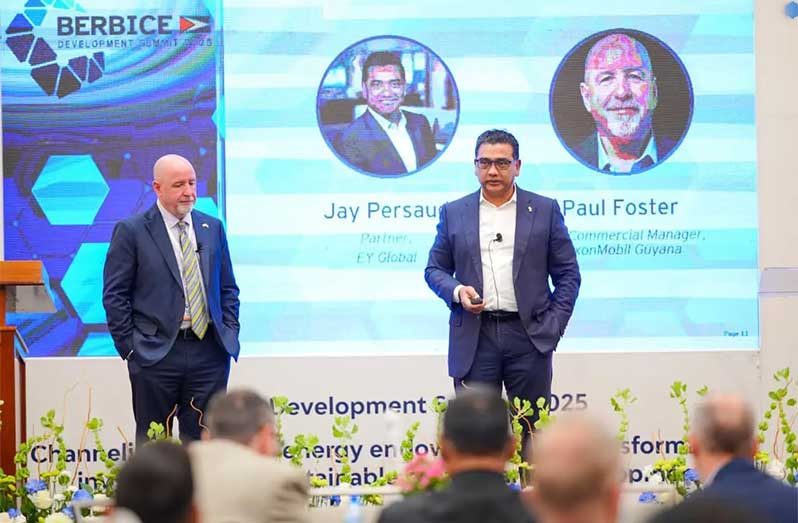By Kiana Wilburg
LED by President Irfaan Ali, Guyana’s long-term development strategy is poised to take a decisive step forward, given plans that were recently discussed at the Berbice Development Summit on November 11.
At that event, the head of State, along with senior officials from ExxonMobil, outlined a vision that aligns with the administration’s 2020-2025 plans to diversify the economy beyond oil, ensuring prosperity is shared across the country. What emerged from the forum was a clear message: Berbice is being positioned as a new centre of gravity in Guyana’s economic boom, with natural gas as the underpinning resource.
For several years, the administration has sought to ensure that the country’s economic boom extends beyond Georgetown and its surrounding regions. Billions of dollars from oil production are already reshaping coastal infrastructure, services and employment patterns in the capital and Region Three. But President Ali has consistently stressed that the national development project cannot be distributed unfairly.
Berbice, historically underserved and often seen as receiving fewer major projects than other areas, has been elevated as the next major beneficiary of the country’s growing economic fortune. The government’s vision for Berbice includes a gas-powered industrial hub featuring some of the largest and most sophisticated commercial developments ever proposed for the region, including a 2-gigawatt data centre, heavy industry plants, and a network of upgraded roads, ports, bridges and fibre infrastructure. Realising this vision requires upstream resources and alignment across energy, industrial planning, digital connectivity, logistics and investment.
That is precisely why ExxonMobil’s comments at the summit resonated so strongly. Paul Foster, ExxonMobil Guyana’s Commercial Manager, presented an assessment of Berbice that reinforced the government’s long-term strategy. He described the region as offering rare locational advantages: abundant water, reliable energy potential and, crucially, a geographic profile that avoids the hurricanes, earthquakes and other natural disasters that plague much of the hemisphere.
“Data centres don’t like hurricanes, floods or earthquakes,” he said.
Foster also said the region is close to major markets in the United States and Latin America, and noted that Guyana can establish subsea fibre links to North America and Europe at relatively modest cost. This is not a minor point. The government has placed a high priority on developing a robust digital economy, and the presence of world-class fibre connectivity would make Berbice a competitive location for large-scale technological investments that simply were not possible a decade ago.
But Foster’s most important message centred on timing and coordination. For the Berbice hub to become commercially feasible, ExxonMobil and investors must align their plans with government policy and with one another.
“The whole value chain ultimately has to hang together,” Foster said, noting that early alignment ensures that no single participant carries disproportionate risk.
Natural gas upstream investments tend to require the support of downstream industries, ready investors, clear commercial agreements and operational preparedness.
This message aligns directly with the government’s push to unlock the natural gas resources offshore, particularly in the southeast portion of the Stabroek Block, where the Haimara and Pluma fields hold the most substantial gas potential discovered to date. While ExxonMobil has already brought four oil projects into production, raising output to around 900,000 barrels per day, and has oil, condensate and smaller-scale gas projects lined up through 2031, the administration has consistently urged the company to bring the massive Haimara and Pluma gas fields forward.
Guyana’s industrial vision for Berbice requires a reliable, long-term supply of natural gas, not just associated gas from oil fields. Longtail, set to start production in 2031, will be the country’s first non-associated gas development, but its volumes will need to be supplemented with what Haimara and Pluma could supply. Those fields are expected to represent the backbone of the Berbice industrial development strategy.
The emerging plan involves laying a subsea pipeline from these fields to Berbice, creating a reliable, high-volume gas supply that can support power generation, heavy industry, petrochemical processing, and the proposed 2-GW data centre.
President Ali stated plainly that he is “not willing to push monetisation beyond 2030,” indicating that his administration expects the gas development decision to be made within his constitutional term, which ends in 2031. He called for minimal debt financing and greater participation from foreign, regional and diaspora investors, stressing development that is fiscally responsible and driven by the private sector.
If the government succeeds in coordinating the gas supply, the pipeline, investor decisions, infrastructure upgrades and industrial planning, the result will be a transformation of historic scale. Berbice could shift from being a region long overshadowed by the capital to becoming a powerhouse of industrial activity. That is the tsunami of investment that the government is preparing the ground to facilitate.



.jpg)








